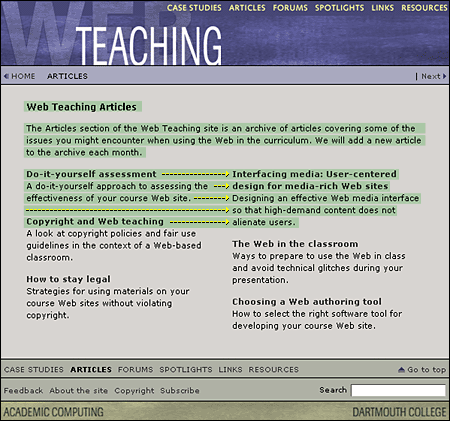 | |
AccessibilityMany accessibility issues have to do with presenting certain types of content, and these are covered in the chapters on typography, graphics, and multimedia. But you can take measures with your page design to improve access for users with physical disabilities, particularly those who use assistive technologies to access Web pages. There are also basic decisions you'll need to make about your design approach: whether to adopt a no-holds-barred stance and push the boundaries of Web design or create simple, clear designs that will accommodate all users. Layout tables that make senseThe biggest page-design barrier for disabled users is the use of layout tables. In particular, layout tables can make things unpleasant for blind users. Many blind users rely on software that reads Web pages aloud or outputs information to a speech synthesizer or braille display. Current software looks at the HTML code of the pages and reads tables in a cell-by-cell, or linearized, fashion. This means that each cell of the table becomes a line or paragraph of text that is read in sequence (imagine releasing all content from table cells and displaying it down a single-column page). A complex layout containing multiple nested tables will produce a sort of aural cubism, with unrelated bits of information appearing from nowhere and disrupting the natural flow of the content. Worse still is the case with older screen readers, which look not at source code but instead at the rendered page. This software starts at the top left of the page and reads line by line, producing a garbled stream of gibberish for the multicolumn layouts that are so common on the Web.  The best solution is to use CSS instead of layout tables to create columns and to control spacing, but as discussed above, browser support remains too patchy and inconsistent for style sheet positioning to be a real option (see Layout with Style Sheets). Until CSS support improves, keep your use of layout tables simple and clean. Each time you add another nested table, first consider whether it is essential to your design and if the function could be handled some other way. The simpler the table, the better sense it will make when linearized. AlternativesAttention to accessibility needn't squelch the creative and experimental nature of Web design. There is room on the Web for designs based on complex tables, large graphics, and technologies such as Flash, but these pages need to come with an equivalent, accessible version. If there is simply no way to design your primary pages for access, provide a link to an alternative page containing the same or equivalent content in a more accessible format. If you use graphics for navigation, be sure to include redundant text links so that those users who cannot see your graphics have an alternate method for navigating your site. Also be sure to include the Clarity and consistencyAll users benefit from clear and consistent Web site design, but for some users it is critical. With a lack of spatial cues and with radically different approaches to navigation that must be relearned at every site, it is far too easy to get disoriented or lost on the Web. For people with cognitive disabilities such as memory or learning disabilities, this difficulty is magnified manyfold. In the long run, there is really no place on the Web for a clever, quirky, or highfalutin design approach. Stick with a simple language and navigation applied consistently throughout your site, and everyone will benefit. |
|
|